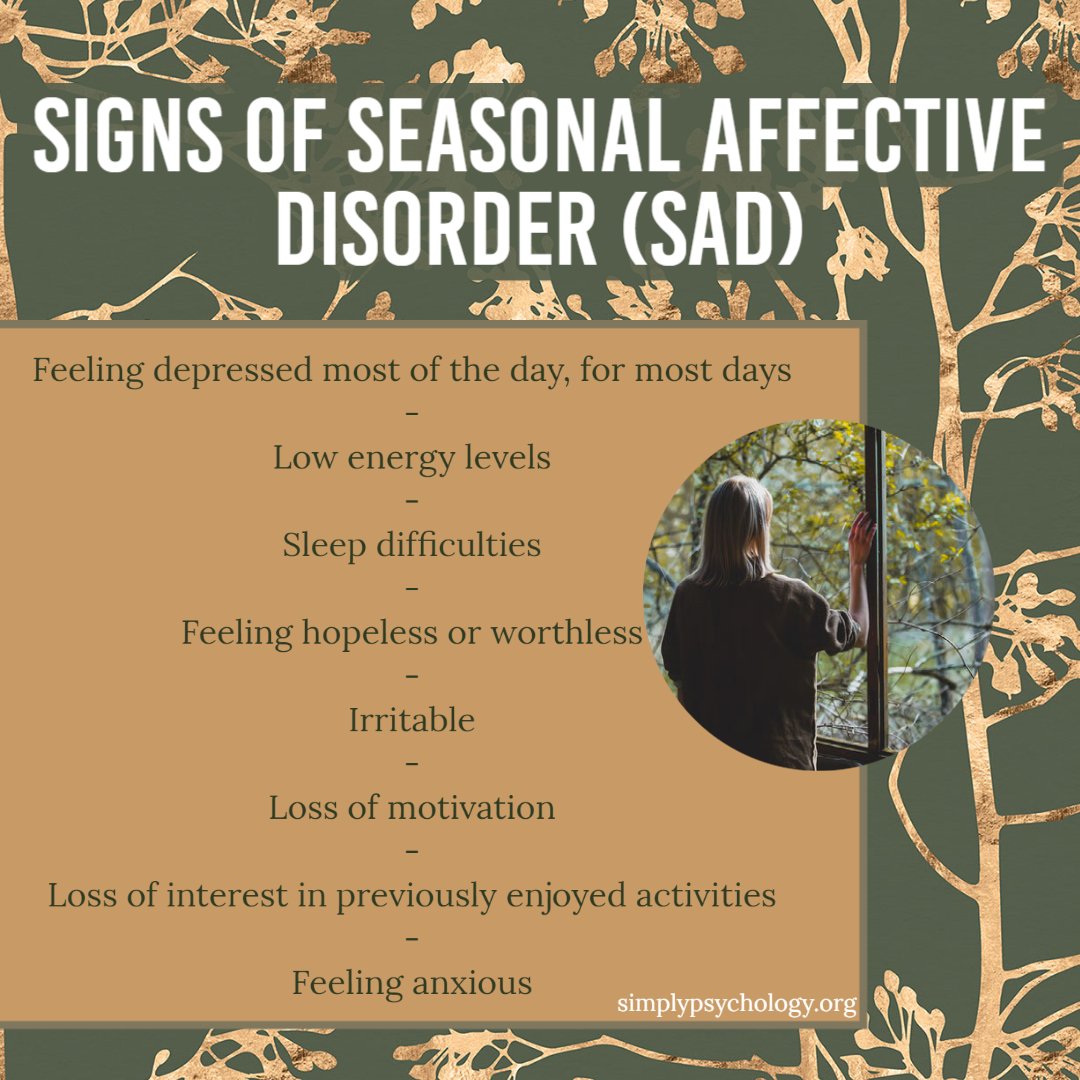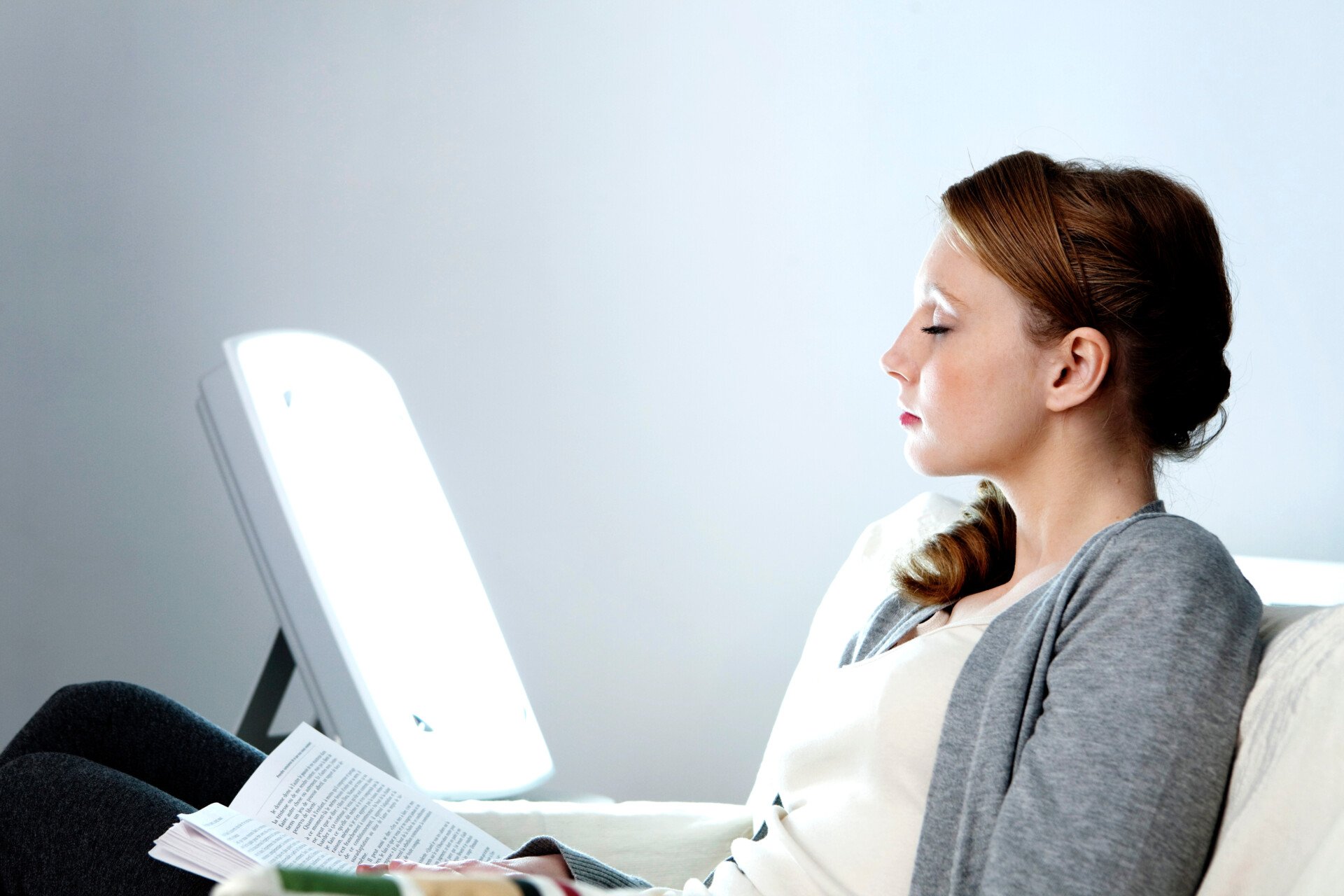On This Page:
Seasonal Affective Disorder (SAD) is a form of depression that typically occurs during the fall and winter months, when daylight hours are shorter (although it can also occur in spring and summer months).
SAD can cause symptoms such as persistent sadness, low energy, changes in appetite, and difficulty sleeping. Additionally, some people may experience irritability, feelings of hopelessness, and difficulty concentrating.
Treatment options for SAD include light therapy, psychotherapy, and medication, and making certain lifestyle changes like getting regular exercise and spending more time outdoors can also be helpful.
SAD is a condition that begins and ends at around a particular time every year for people who suffer from this, which makes it different from other mood disorders.
Most individuals with SAD experience symptoms in the winter months, making them feel lower in mood and lacking in energy. In rare cases, another form of seasonal depression can occur in the spring and summer months.

SAD is most common in countries in northern climates, affecting approximately 6% of the population of the United States and 3% of the United Kingdom, for instance.
The onset of SAD can begin at any age, but typically the first instance is noticeable between the ages of 18 and 30.
Symptoms of SAD
There are typically two types of SAD: winter SAD and summer SAD.
Winter SAD is the most common and recognizable type of SAD and usually begins in late fall or early winter. A rarer case of SAD is summer-onset SAD, often called summer depression. This will usually occur in the spring or early summer.

Some of the general symptoms of SAD may include:
- Feeling depressed most of the day, for most days
- Low in energy or fatigued
- Sleeping too much or difficulties sleeping (insomnia)
- Lack of appetite or eating too much
- Unintentional weight gain or weight loss
- Feeling sad, hopeless, worthless, or guilty
- Irritability and agitation
- Lack of interest in social activities
- Reduced sexual interest
- Loss of motivation
- Difficulty thinking, concentrating, or making decisions
- Thoughts of suicide
- Feeling anxious
It is important to note that SAD can present differently in different people, and they may not experience all of these symptoms.
Some of the symptoms may be more common in winter SAD such as sleeping more often or gaining weight, compared to someone experiencing summer SAD experiencing insomnia or weight loss.
Complications
If left unmanaged, individuals with SAD may be at a higher risk of developing social anxiety since many people with SAD may withdraw from social situations more often when experiencing down moods.
This could result in losing social support networks or finding it harder to socialize again once the seasonal depression has ended. Another impact of SAD may be the abuse of substances like alcohol and drugs as a way of coping with their symptoms.
This can ultimately lead to a dependence on these substances and lead to further mental health and physical health issues. If left untreated, SAD could result in suicidal thoughts or self-harming behaviors.
What causes SAD?
The precise cause of SAD is unknown, and factors may vary from person to person. However, there are some explanations for why certain people experience this condition.
A risk factor for developing SAD could be due to geographical location. Those who live in countries that do not have a lot of sunlight are more at risk of developing SAD than those who live in countries with more sunlight.
This will usually be countries that are furthest away from the equator, such as Canada and Iceland for instance. These countries tend to have longer hours of darkness during the winter months and longer days of sunlight during the summer. These inconsistencies in the seasons may be a strong cause for the onset of SAD.
Similarly, reduced levels of sunlight in winter can disrupt the body’s internal biological clock, which regulates hormones, sleep, and mood. This can result in more depressed feelings.
Serotonin is a hormone that works as a neurotransmitter in the brain. It plays a key role in mood and is associated with mood disorders.
Reduced sunlight can cause a decrease in serotonin being produced in the brain. If there is not enough serotonin circulating in the brain, this can lead to lower moods and fatigue.
Another hormone is melatonin which plays an important role in mood and sleep patterns. Changes in the seasons can disrupt the balance of the body’s levels of melatonin and thus can cause feelings of sadness and sleep problems.
A study in 2014 investigated some of the characteristics that may be associated with individuals with SAD. It was found that females were significantly more likely than men to experience SAD, which tends to be a common finding for this condition.
Likewise, the researchers found that those who score higher on the neuroticism scale (a personality trait characterized by negative effects such as anxiety, irritability, and emotional instability) for personality were more likely to report symptoms of SAD (Oginska and Oginska-Bruchal, 2014).
Diagnosis
The Diagnostic Statistical Manual of Mental Disorders (DSM-IV) describes SAD as not a separate condition from depression but as a type of this – major depressive disorder with seasonal patterns.
SAD is mainly characterized by a seasonal pattern of depressive recurrences over the years.
To meet the criteria of SAD, depression should only be present at a specific time of the year.
For most people, this is usually in the late fall or early winter months but can be at the end of spring or the start of summer in rarer cases.
An individual should demonstrate at least two episodes of depressive disturbance in the previous two years.
Seasonal episodes of depression should also substantially outnumber nonseasonal episodes of depression. Meaning that the depression should be seasonally specific as depressed episodes experienced all year round would probably qualify for major depressive disorder on its own rather than SAD.
Individuals who meet the criteria for SAD may be more likely to report atypical symptoms alongside the typical symptoms of depression. These atypical symptoms may include hypersomnia, increased appetite, and a craving for carbohydrates.
At least five symptoms of depression must be present during the same two-week period, nearly every day, and represent a change from normal behaviors.
At least one of the symptoms being experienced to meet the DSM-5 criteria must be either a depressed mood or a loss of interest or pleasure.
The symptoms being experienced must also not be accounted for by other medical conditions, substance use, another mood disorder, or a bereavement.
These symptoms also should not be explained by a psychotic disorder such as schizophrenia.
Treatment and prevention
While symptoms of SAD will generally improve on their own with the changing seasons, these symptoms can be improved quicker with treatments.
Some of the treatments will be the same for depression in general.
The predictability of when SAD will occur, it can make it easier to know when to begin treatments.
Light therapy
Light therapy is a common treatment for winter SAD. This involves sitting in front of a light therapy box that emits a bright light, filtering out harmful UV rays.

The aim of this is to try to mimic the sunlight that is not as prevalent in the winter months. This treatment is linked with the melatonin theory of why SAD symptoms may occur in winter.
As sunlight can affect the biological clock, the use of light therapy should help to restore the balance of melatonin and increase mood.
The amount of time spent in front of the lightbox can vary, but it is usually recommended to sit in front of it for about 20 minutes a day in the morning during the winter months.
Most people report some improvements in mood within a couple of weeks of regular light therapy. It can also be used to prevent the onset of SAD symptoms.
If someone anticipates that their SAD symptoms will return in the late fall, for instance, they could use the lightbox in the early fall to help prevent symptoms.
Light therapy is a non-pharmacological treatment that is generally safe to use. Some of the research into the effectiveness of light therapy is limited with small sample sizes, and it may not be a suitable treatment for those experiencing symptoms such as suicidal thoughts. Still, it can be used at the individual’s discretion.
Medication
Alternatively, the use of antidepressants, specifically selective serotonin reuptake inhibitors (SSRIs), which are used to treat depression, can also be an effective treatment for SAD.
SSRIs affect the neurotransmitter serotonin in the brain by blocking the reuptake of serotonin back into the neuron, which releases it.
With more serotonin circulating between the neurons, this makes it more likely that the serotonin will reach the next neuron and have more of an effect on the brain and mood.
SSRIs are widely used and accepted as an effective treatment for symptoms of depression, although it may not be recommended to continue use once the season of depression is over.
SSRIs require a gradual withdrawal, decreasing the dose over time. This can make it difficult to stop once the winter is over, and thus needs to be considered if beginning this treatment.
Psychotherapy
Psychotherapies are also proven to be a useful treatment for depression and specifically for SAD.
Cognitive behavioral therapy (CBT) is a popular type of psychotherapy that involves working with a therapist to talk through unhealthy behaviors and thoughts as part of the symptoms of depression.
Together with the therapist, the vicious cycle can be solved by altering the unhelpful thinking and behaviors of the individual into more healthy and realistic ones.
Prevention
Aside from treatments, some preventative measures can be taken to help stop or limit the severity of the symptoms of SAD.
Taking some time to be outside, even if there is little sunlight, or sitting near a window in the home, can help with improving mood.
Similarly, taking care of general health, such as eating well and regular exercise, especially near the predicted onset of SAD, could help improve symptoms.
Finally, keeping a good social network, meeting friends and family, or participating in group activities should also help.
Do you need mental health help?
USA
Contact the National Suicide Prevention Lifeline for support and assistance from a trained counselor. If you or a loved one are in immediate danger: https://suicidepreventionlifeline.org/
1-800-273-8255
UK
Contact the Samaritans for support and assistance from a trained counselor: https://www.samaritans.org/; email jo@samaritans.org .
Available 24 hours a day, 365 days a year (this number is FREE to call):
116-123
Rethink Mental Illness: rethink.org
0300 5000 927
Further Reading
References
Saeed, S. A., & Bruce, T. J. (1998). Seasonal affective disorders. American family physician, 57(6), 1340.
Magnusson, A., & Boivin, D. (2003). Seasonal affective disorder: an overview. Chronobiology international, 20(2), 189-207.
Oginska, H., & Oginska-Bruchal, K. (2014). Chronotype and personality factors of predisposition to seasonal affective disorder. Chronobiology international, 31(4), 523-531.

